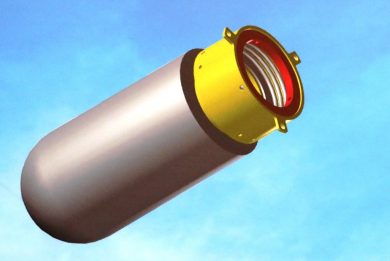Eurosatory 2024 – KNDS loitering munitions: Larinae and Colibri
In November 2022 the French General Direction for Armaments (DGA) and the Innovation Defence Agency (AID) closed the request for proposal aimed at developing two loitering munitions, the bigger one with a 50+ km range and the smaller one with a range of over 5 km, named respectively Larinae and Colibri. The development contract was assigned to two companies, KNDS and MBDA. In the KNDS stand at Eurosatory 2024 the two models were exhibited, with deep modifications from what was showcased during the Paris Air Show 2023
One year ago, on Friday, June 16th, the French AID assigned to a team of companies led by KNDS France a development contract for the Larinae loitering munition, which in French wording becomes a Munition Télé Opérée (MTO), or remotely operated munition. The Larinae team includes what was Nexter Arrowtech, now KNDS France, which provides the warhead, EOS Technologies that provides the UAV system and Traak in charge of the navigation solution, not much information being provided on the latter.
The main requirements were the following:
- neutralization of an armored vehicle by direct impact of the system or by delivering the ammunition;
- metric targeting precision;
- a minimum of 60 min flight autonomy over the area of interest located 50 km from the take-off point;
- a safe deployment for operators, and no risk of jamming or takeover by external players; easy deployment, with no need of runway or prepared terrain.
Add-on optional requirements were the capacity to neutralise different types of targets, to neutralise a moving target travelling at 50 km/h, an increased range, resistance to jamming, and a recovery system should the attack mission ne aborted.
The model of the Larinae seen at Le Bourget 2023 was based on a glider-type airframe, developed by EOS Technologies, which featured an aerodynamically shaped fuselage with mid-wing and T-shaped tailplane, which could also be fitted with two pods equipped with two rotors each allowing vertical take-off and landing (VTOL). What was exhibited at Eurosatory 2024 was a wholly different system.
The “new” Larinae
EDR On-Line understood that this is due to the changing in customer’s requirements, the French Army, DGA and AID having analysed lessons learned from the Ukrainian conflict. Speed has become a key parameter, hence the airframe has now a completely new aspect. What seen at the Paris exhibition is a blended wing body with a lifting fuselage, which lift-to-drag ratio is very close to that of a glider but with the payload capacity of an airplane.
EOS Technologies worked deeply on aerodynamics, as the airframe is required to properly fly both at low and high speed, say 100 km/h and 500 km/h. EDR On-Line understood that the lift-to-drag-ratio is around 27, very close to the figure declared for the glider-like airframe seen last year which was 30. The whole body is made of composite materiel, but no carbon fibre is used for a series of reasons, according to the company; first, cost, second the tendency of rigid structures to resonate, third its high radar reflection, and finally its high conductivity that shields RF signals, impeding to install antennas within the fuselage. Last year EDR On-Line was told by EOS Technologies representatives that the company developed a composite material without carbon fibre, an innovative manufacturing process allowing producing very light and strong elements at a much lower price, this being quite probably similar to that used in the new airframe. Its design was also optimised to make it easily producible, loitering munitions being expandable high production rates being required. EOS Technologies will partner with major players when the need to mass-produce the airframe will materialise. Using the same airframe, which has a 3.3 metres wingspan, EOS Technologies proposes different types of solutions, ISTAR 330, ISTAR 330 VTOL, Rodeur 330 and Veloce 300.
The latter was the one exhibited at Eurosatory and is the answer to the need for a higher speed; it is powered by a jet engine provided by ALM Méca, a company based north of Strasbourg specialised in turbojets for aviation and modelling. The A-120 has a 120 N thrust and has a mass of around 1.4 kg and allows the Larinae to reach a cruising speed of 200 km/h and a maximum speed of 400 km/h, with a range of 100 km and a 6 kg payload, versus a take-off mass of around 27 kg.
The warhead is produced by KNDS France; named Arceus, it is based on an explosively formed penetrator (EFP) and weighs around 3 kg, fitted with a proximity fuse, KNDS stating that it has the same penetration capacity than the Bonus artillery round submunitions, albeit it has a much smaller diameter.
The IMINT payload
The airframe also carries an optronic suite with day and night cameras, one pointing forward and one pointing downwards, which provide respectively metric precision and GPS precision. The E/O package allows to carry out Image Intelligence (IMINT) and is based on the Raptor gimbal by Nextvision, which weighs 640 grams and has a pitch of -45°/+80° and a roll of ±180°. It hosts an uncooled thermal sensor operating in the long-wave infrared with a 1280×720 matrix, with a x40 optical zoom and an add on x2 digital zoom, and a visible channel with a 1980×1080 pixels resolution. According to available data detection, recognition and identification ranges against vehicles are respectively 20/3/1.5 km in the visible spectrum and 4/1.7/0.8 km in the infrared spectrum, while against humans these are 5/3/1.5 km and 2.5/0.6/0.3 km. The Raptor provides geo-referenced images, is capable to track static and moving targets, can detect and classify shapes, read license plates and undergo multispectral analysis.
The Larinae can engage fix and moving targets, the data link limiting its range at 100 km which it can reach in less than 30 minutes, endurance being between 15 and 30 minutes depending on the speed, fuel consumption ranging from 300 ml/min to 440 ml/min, depending on rotational speed. Operational ceiling is 5,000 metres.
The Larinae can be deployed in less than 5 minutes, and takes off from a catapult, the whole system being fitted in a box that can be transported on a pick-up vehicle.
The gasoline engine solution, more than a munition
A second option is the one based on the Rodeur 330, which maintains the same airframe of the previous one but is powered by a gasoline engine, cruising speed being 80-100 km/h. What is considerably increased is endurance, which goes up to 6 hours, which allows a range of 500 km with the same payload. This version can be fitted with the same warhead and optronics, but can also be used for SIGINT missions, replacing the Arceus warhead with an electronic warfare package. Two such payloads are proposed, Thales the Vortex XS phone tapping and geolocation device by Suneris, a Thales company, and MC 31 Icatch cellular communications eavesdropping device by Avantix, part of the Atos group.
Electric loitering munitions
As said two more systems are based on the same 3.3 metres wingspan blended wing body airframe, both with electric propulsion. Both the ISTAR 330 and the ISTAR 330 VTOL have the same 27 kg maximum take-off mass of the previous systems, same ceiling, and same cruising speed of the Rodeur 330. The payload is reduced to 4 kg, and can be a mix of IMINT, SIGINT and warhead, the data link ensuring a 120 km range. The VTOL version has 3 hours endurance while the conventional airframe can fly 2 hours more.
Larinae first tests
According to EOS Technologies the catapult take-off was planned just after the exhibition, the first demonstration to the customer being planned for December 2024, without the warhead, while a full demo with payload is awaited in June next year. In perspective the company is looking at a bigger version of its 330 airframe, with a 25-30 kg payload, powered by a 240 N thrust turbojet, a sort of “French Shahed” so to speak. In the end the Larinae can be developed in four different forms, a high speed loitering munition, a long range one, a stealth one and a VTOL stealth one, ISTAR versions being also a possibility thanks to the multiple payload capacity.
The Colibri
Coming to the Colibri, the main requirements were the following:
- the neutralization of a light vehicle;
- metric targeting precision;
- a minimum flight autonomy of 30 min in the area of interest located 5 km from the take-off point;
- a safe deployment for operators, and no risk of jamming or takeover by external players;
- easy deployment, with no need of runway or prepared terrain;
- minimal bulk allowing transport by a single fighter.
The Colibri is based on the Delair UX11, a low-cost airframe made of a special polystyrene material, which has a take-off mass of 2.3 kg including the 500 grams pre-fragmented last generation charge by KNDS France; this is usually fitted with an impact fuse, but it can optionally adopt time fuse to operate in airburst mode, for example against troops in the open. A flying wing powered by an electric motor activating a two-blade pushing propeller, it can reach 60 km/h, fly up to 45 minutes and its data link allows encrypted communications up to 25 km. It can be transported in a rucksack and is launched by hand.
The full test with warhead was scheduled for the week following the end of Eurosatory, the Colibri team planning to deliver the first 100 Colibri loitering munitions within July.
Photos by P. Valpolini









